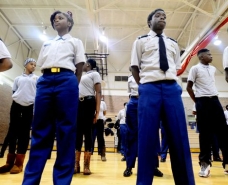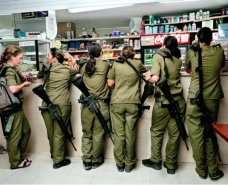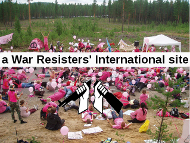Catch them young before the army loses them
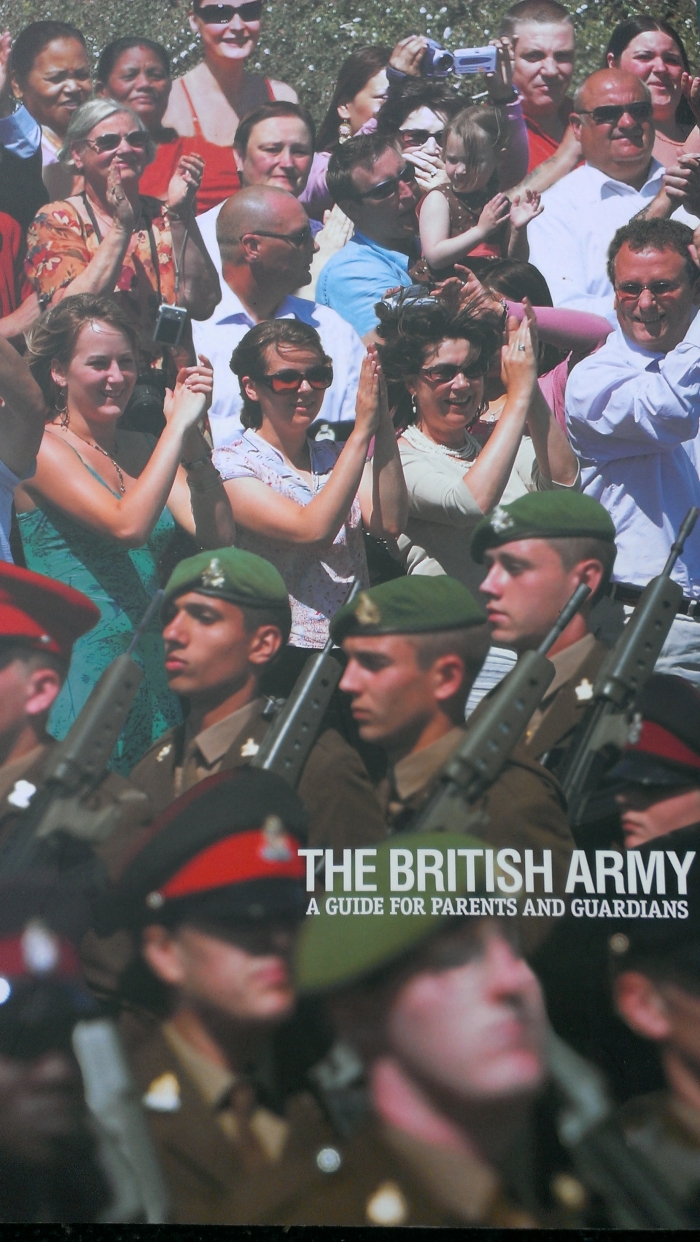
David Gee -
Ask a teacher what her purpose is and how she goes about it, and you can expect a simple answer: she supports young people to grow by teaching them things. We know why we need bakers, too; they feed people by baking us bread. So what are soldiers[2] for?
Their purpose, say the politicians who choose which wars are fought, is to defend the nation. In fact, most soldiers do little defending. All recent wars involving European or North American forces have been conflicts of choice; in the former Yugoslavia, Iraq and Afghanistan, Western states have initiated invasive wars by projecting military power far from home. There is no public consensus on whether these actions reflected the wise and courageous intentions of dispassionately humanitarian people, or bids to shape the geopolitics of the world for the benefit of its most powerful states. History shows that there are several purposes of armed forces, of which some are possibly benign but not self-evidently so, and others are plain malevolent. In effect, the soldier’s purpose in war is not always, or even usually, to defend the nation, but rather to help win whatever struggle his political leadership has decided to wage.
The purpose of armed forces may be vague; the soldier’s role in it is not, even if this is rarely spelt out. It is no use looking for a description of the soldier’s role in military recruitment literature. The brochure for the British Infantry, for example, describes the infantryman’s job as to ‘defeat the enemy’, ‘engage an enemy’, ‘engage the target’, make ‘decisive strikes’[3] – all fantasy euphemisms as nonsensical as a baker who ‘facilitates nutrition’ or a teacher who ‘pedagogicalises information’. If the teacher teaches and the baker bakes, then the soldier soldiers. What does this involve? General Michael Rose, who commanded UN forces in Bosnia, is unusual among his peers in his frankness: ‘No other group in society is required either to kill other human beings, or expressly sacrifice themselves for the nation.’[4] Essentially, the soldier’s job is to kill or threaten to kill (a word absent from the 12,000-word Infantry brochure) and accept the risk of being killed or injured. This is just as true of humanitarian peacekeepers – their guns are not loaded for nothing.
Recruiting the most vulnerable
Given that the purpose of armed forces is not self-evidently benign and that the job of soldiers is a mortally dangerous one primarily requiring the killing of other people, who would freely choose to make this their career choice? Put another way: how do the social and political elite of nation states persuade enough people to fight their wars?
The answer is that they take an interest, hitherto probably lacking, in those social groups whose life options are fewest and whose choices are made from a position of relative weakness. These are young people who remain impressionable and have yet to develop the psychological maturity of adulthood. They are poor people whose education has been sub-standard, who have few civilian job opportunities available, and who may have young families to support. And they are people from ethnic minority groups at a social disadvantage when compared with the mainstream majority.
If you are all three – young, poor and from a minority background – then the armed forces are very likely to come calling. They will come to your school, your neighbourhood, your local unemployment agency. They will find you through adverts on TV, at the cinema, and on Facebook. They will offer you glossy leaflets, internet games, military clubs to join, and a chance to sit in a battle tank, hold a rifle or feel the controls of a fighter bomber. They will start this while you are still too young to enlist. When you are old enough to join the forces, they will promise you adventure, a developing career, new friends, a feeling of personal power, and a sense – often for the first time for many potential recruits – of belonging with others to a cause. They are not there to exploit your weak social position, they will insist, but to offer you a chance to strengthen it. The state, largely responsible for the social conditions of poverty in which you live, will now save you from them by giving you a job. Their rhetoric is that of having done you a favour, albeit one that very few people a little older than you or from a more privileged background would accept.
The cover of the 2006 British Army recruiters guide for parents has a doctored photo of a 'passing out' parade, where ethnically-diverse faces have been inserted to attract families of potential recruits from non-white backgrounds (credit–David Gee)The cover of the 2006 British Army recruiters guide for parents has a doctored photo of a 'passing out' parade, where ethnically-diverse faces have been inserted to attract families of potential recruits from non-white backgrounds (credit–David Gee)
The realities of military life
The reality of armed forces life is nothing like the brochures and online ads. New recruits in all countries become subject to special national and international laws that nullify many civil, political and human rights, such as the right not to be required to perform forced or compulsory labour.[5] The legal obligations of enlistment prevent those who want to leave from doing so (for four years or more in the UK[6]); soldiers may be incarcerated if they try and many have been. Young people from the poorest neighbourhoods targeted by recruiters[7] typically have underdeveloped literacy skills, which puts them at a disadvantage when trying to understand the complex commitments involved in order to make a free and informed choice.
Some recruits are happy with their career choice and will stay that way, but although statistics from the UK show that there are more happy soldiers than unhappy ones, job satisfaction is still lower in the armed forces than in civilian life.[8] Whether or not they like their new job, armed forces recruits face a barrage of physical and psychological risks. British and US studies show that mental health problems in the military are higher than in the general population, with much higher levels of harmful alcohol use, appreciably higher rates of post-traumatic stress disorder (PTSD), and similar or slightly higher rates of anxiety and depression.[9] Deployment to war zones increases the risks further, especially for those in direct combat roles such as the Infantry and those who enlisted young and from disadvantaged backgrounds.[10] As exposure to warfare increases or intensifies, traumatic events such as being shot at, handling dead bodies, seeing someone being killed, and killing or wounding other people, again increase the prevalence of clinically significant mental health problems.[11] Young recruits from disadvantaged backgrounds are much more vulnerable to these risks.[12] In the UK, soldiers who enlisted at the youngest age (16) have been substantially more likely to lose their lives in Afghanistan that those who enlisted aged 18 or above[13]; given that the risk of being injured has been about five times that of being killed[14], recruits enlisting younger also face a higher risk of non-fatal injury. In the British and US context, and probably elsewhere as well, the youngest recruits from the most disadvantaged neighbourhoods are also most likely to occupy the most dangerous roles, such as in the Infantry, because these jobs are relatively unskilled and require fewer or no qualifications.[15] Even at times of low deployment, the youngest recruits are more likely to be bullied and, especially if female, sexually harassed.[16]
The overall picture is that the youngest people from the poorest backgrounds are both most vulnerable to mental health problems and also most likely to occupy military roles with high levels of exposure to traumatic events. For example, one British study found that 17.5% of personnel under twenty years of age had symptoms of PTSD in the Gulf War[17] and another found that the prevalence of PTSD symptoms among those who joined the armed forces with no qualifications (these are likely to have enlisted youngest, including straight from school) was 18.4%.[18] These rates of PTSD are far higher than the 3.0% found in the general UK population.[19] Equally striking is that harmful alcohol use in the youngest military age group, and in recruits from the most disadvantaged backgrounds, has been found to be three times as prevalent as in the general population.[20] The common assumption that recruiting disadvantaged youngsters is good for them just does not stand up to scrutiny.
The situation elsewhere
Since conditions in the British and US armed forces have much in common with those of other industrialised states, it is likely that young people in other countries also face heightened psychological and physical risks when compared with adult recruits or the general population.
When nine of us, each from a different country[21], explored this issue in a workshop at the Countering the Militarisation of Youth conference in Darmstadt, we all described similar armed forces recruitment tactics: active marketing to young people, especially from poor communities; the glamourisation of military jobs as a route to an adventurous life, especially by presenting the soldier, sailor or airman as a hyper-masculine role; and the omission or glossing over of the substantial risks and difficulties involved. All of us were concerned about this militarisation of youth and the harm it causes to young people’s wellbeing for the sake of armed violence orchestrated by the elite class of the older generation.
In all our countries apart from Switzerland, military recruitment has flourished in conditions of local poverty and/or episodes of national economic crisis, where there are few civilian job options available. In most countries, a job in the armed forces is the only apparent way for some male bread-winners to be able to provide for their families; this is especially the case in poorer countries like Ghana or very unequal societies like South Africa. Recruitment is also successful where there is a high level of national pride in the state armed forces, which spend large sums to encourage this sentiment through parades, advertising and national days to celebrate themselves.
In all the countries of which we had experience (except, again, Switzerland), the armed forces actively target their marketing at the youngest recruits. Whilst the emphasis in general remains on appealing to boys of school-leaving age, most armed forces now also have dedicated programmes for recruiting women.
People from immigrant backgrounds appear to be an emerging priority for recruiters. Sweden has specific armed forces recruitment programmes targeted at these communities, which are tied in with state unemployment agencies.[22] In the UK, focused recruitment drives among black and minority-ethnic groups had increased their representation among enlisted recruits from 6.1% in 2006 to 7.9% in 2012.[23] However, the proportion of black or minority-ethnic officers remains unchanged at just 2.4%, reflecting the abiding class difference between commanders and commanded.[24] In both groups, the proportion of people from black and minority-ethnic backgrounds is much lower than that in the general proportion, at 14%.[25] Whilst in some countries, such as Sweden, recruits with immigrant backgrounds might be valued positively for their cultural knowledge[26], generally the armed forces capitalise on the socio-economic weakness of minority populations in order to fill the ranks.
Since presenting a more realistic picture of military life would leave recruiters a long way short of their recruitment targets, they have to engage in a propaganda exercise. As one recruiter put it to me: ‘You have to tell the truth... to a degree.’[27] Degrees of truth implies degrees of lies or omission. Understanding how recruitment propaganda is constructed helps to inform effective challenges to it. A fundamental weakness of military recruitment is that it has to persuade young people of two things that are not true. The first claim aligns soldiering with civilian society. It says that soldiering is a normal thing to do; it is a career choice no different in kind from being a teacher or a baker; powerful armed forces are needed as part of what makes a society civilised; the lifestyle of a soldier is almost the same as a civilian’s anyway. The second claim, paradoxically, elevates soldiers above civilian society. Joining the army automatically makes you special, powerful, more of a person, even a hero.
This pattern is common to European countries relying on ‘voluntary’ recruitment and which are not involved in military conflict on their own soil. It is also true of Ghana, where being a soldier attracts social status and high pay, and South Africa. It seems to be less the case in the countries represented at the Darmstadt workshop which do not need to market military careers, usually because they rely on conscription, such as Switzerland and Colombia, or where the realities of war are closer to home, such as Colombia.
Responding
Some of the best criticism of this recruitment messaging comes from within armed forces themselves. As General Sir Michael Rose pointed out, soldiering, insofar as it boils down to killing and possibly being killed, is nothing like other jobs. Indeed, it raises searching ethical questions, of which perhaps the most fundamental is ‘Can killing be humane?’ Personally, I believe that the main challenge for activists is not to persuade young people of a specific view about the rights and wrongs of violence, but to help make sure that these questions are being asked when someone considers signing up. After all, a good choice is not merely a free and informed one, but a responsible one as well.
As for the ubiquitous soldier-hero, this constructed figure is barely recognised by soldiers themselves. I know of no experienced soldier who thinks all soldiers are heroes. Rather, they tend to think this over-used epithet cheapens the genuinely heroic acts of those soldiers who have put themselves at mortal risk for the sake of their comrades. The soldier-hero is a civilian concoction actively encouraged by politicians and the media, which tacitly encourages us to believe (or not to question) that the wars fought in other countries in our name must be noble and necessary. The reality is that many soldiers who have seen the brute horror and political calamity of wars think politicians, who have seen a lot less, are far too ready to start them.[28]
Military recruitment is deeply embedded in the class and economic structures of society. Its methods, thriving on hyper-masculine fantasies of soldiering and, in consumer-capitalist societies in particular, a creeping estrangement from our most humane values, can be understood as a form of human alienation. Even so, despite the continuing success of military recruitment worldwide, it is still perhaps the Achilles heel of militarism. War depends on large numbers of people agreeing to participate in mass killing. If we can work well with young people, their parents, educators and the media, so that equally large numbers pause to reflect on what soldiers are expected to do and why, cracks might open in militarism from the bottom up.
Notes
[1] The title paraphrases a statement by a Committee of the British House of Commons: ‘We believe it continues to be important to recruit young people straight from school, including at the age of 16; if they are not caught at this point, they are likely to take up other careers and be permanently lost to the Armed Forces.’ House of Commons Select Committee on the Armed Forces Bill, ‘Armed Forces: First Special Report’ (London, 2001), paragraph 63 [Online at http://www.publications.parliament.uk/pa/cm200001/cmselect/cmarmed/154/1... (accessed 19 April 2013)].
[2] Throughout this article, the term ‘soldier’ is used as shorthand for enlisted personnel in national armies, navies and air forces.
[3] Ministry of Defence, Army Career Guide to Infantry Soldier (London, 2005).
[4] How soon could our Army lose a war’, The Daily Telegraph, 5 April 1998, cited in British Parliament, House of Commons Defence Committee, 'Duty of Care', 1:28 (2005).
[5] Human Rights Act 1998, Art. IV
[6] Ibid., Ch. 3.1.
[7] David Gee and Anna Goodman, ‘Army recruiters visit London's poorest schools most often’ (2010) [Online at http://www.informedchoice.org.uk/armyvisitstoschools.pdf
(accessed 18 April 2013)].
[8] David Gee, ‘Informed Choice? Armed forces recruitment practice in the United Kingdom’ (London, 2008), Ch. 4.1 [Online at http://www.informedchoice.org.uk/informedchoice/informedchoiceweb.pdf (accessed 16 May 2013)].
[9] Khalida Ismail et al, ‘Occupational risk factors for ill health in Gulf veterans of the United Kingdom’, Journal of Epidemiological and Community Health, 54 (2000), pp. 834-8; Nicola Fear et al, 'What are the consequences of deployment to Iraq and Afghanistan on the mental health of the UK armed forces? A cohort study', The Lancet, 375 (2010), pp. 1783-97; Amy Iversen et al, ‘The prevalence of common mental disorders and PTSD in the UK military: using data from a clinical interview-based study’, BMC Psychiatry, 9:68 (2009), unpaginated [Online at http://www.biomedcentral.com/1471-244X/9/68 (accessed 18 April 2013)]; Matthew Hotopf et al, ‘The health of UK military personnel who deployed to the 2003 Iraq war: a cohort study’, The Lancet, 367 (2006), pp. 1731–41; Margaret Jones et al, ‘The burden of psychological symptoms in UK Armed Forces’, Occupational Medicine, 56 (2006), p. 326; Matthew J. Friedman et al, ‘Post-traumatic stress disorder in the military veteran’, Psychiatric Clinics of North America, 17:2 (1994), pp. 265-77.
[10] Charles Hoge et al, ‘Combat Duty in Iraq and Afghanistan, Mental Health Problems, and Barriers to Care’, The New England Journal of Medicine, 351:1 (2004), pp. 13-22; Hotopf et al, ‘The health of UK military personnel’, pp. 1731–41; Jones et al, ‘The burden of psychological symptoms’, pp. 322-88; Fear et al, 'What are the consequences of deployment to Iraq and Afghanistan', pp. 1783-97; Iversen et al, ‘The prevalence of common mental disorders and PTSD in the UK military’; Friedman et al, ‘Post-traumatic stress disorder’, pp. 265-277; Ismail et al, ‘Occupational risk factors for ill health in Gulf veterans’, pp. 834-8; Amy Iversen et al, ‘Influence of childhood adversity on health among male UK military personnel’, The British Journal of Psychiatry, 191 (2007), pp. 506-11.
[11] Among deployed troops who had experienced no direct combat engagements, the authors found a PTSD rate of 4.5%; among those with experience of five or more direct combat engagements, the rate had risen to 19.3%: Hoge et al, ‘Combat Duty in Iraq and Afghanistan’, pp. 13-22; Friedman et al, ‘Post-traumatic stress disorder’, pp. 265-77. It is important to note that someone who causes trauma to others may themselves be traumatised as a result; this so-called ‘moral pain’ raises questions about the link between mental health problems and unarticulated conscientious objection.
[12] Fear et al, 'What are the consequences of deployment to Iraq and Afghanistan', pp. 1783-97; Iversen et al, ‘The prevalence of common mental disorders and PTSD in the UK military'; Ismail et al, ‘Occupational risk factors for ill health in Gulf veterans’, pp. 834-8; Jones et al, ‘The burden of psychological symptoms’, pp. 322-88; Iversen et al, ‘Influence of childhood adversity on health among male UK military personnel’, pp. 265-77.
[13] David Gee and Anna Goodman, ‘Youngest recruits face greatest risks in Afghanistan’ (London, 2013) [forthcoming – please contact the author].
[14] Calculated from Ministry of Defence, ‘British Fatalities: Operations in Afghanistan’ (2013) [Online at http://www.gov.uk/government/fields-of-operation/afghanistan (accessed 13 March 2013)].
[15] Child Soldiers International and ForcesWatch, ‘One Step Forward: The case for ending the recruitment of minors by the British armed forces’ (London, 2013).
[16] Coalition to Stop the Use of Child Soldiers [now called Child Soldiers International], ‘Catch 16-22: Recruitment and retention of minors in the British armed forces’ (London, 2011), pp. 9-10 [Online at http://www.child-soldiers.org/research_report_reader.php?id=290 (accessed 18 April 2013)]; Sarah Rutherford et al, ‘Quantitative & Qualitative Research into Sexual Harassment in the Armed Forces’ (Equal Opportunities Commission and the Ministry of Defence, 2006).
[17] Ismail et al, ‘Occupational risk factors for ill health in Gulf veterans’, pp. 834-8.
[18] Iversen et al, ‘The prevalence of common mental disorders and PTSD in the UK military'.
[19] Sally McManus et al (eds), ‘Adult psychiatric morbidity in England, 2007: Results of a household survey’ (National Health Service, 2009) [Online at http://www.ic.nhs.uk/pubs/psychiatricmorbidity07 (accessed 13 May 2010)].
[20] Ibid.
[21] Colombia, Holland, Germany, Ghana, South Africa, Spain, Sweden, Switzerland, UK.
[22] Swedish activist, personal communication, 14 April 2013.
[23] Defence Analytical Services and Advice, ‘Strength of UK Regular Forces by Service and ethnic origin, at 1 April each year’ [Online at http://www.dasa.mod.uk (accessed 6 January 2013)].
[24] Ibid.
[25] Office for National Statistics, ‘Ethnicity and National Identity in England and Wales 2011’ [Online at http://www.ons.gov.uk/ons/dcp171776_290558.pdf (accessed 6 January 2013)].
[26] Swedish activist, personal communication, 14 April 2013.
[27] Recruiting staff, London, personal communication, November 2007.
[28] See for example Ken Lukowiak, A Soldier’s Song (London, 1993); Lee Jones, Nobody's Hero: A Reluctant March Through the Middle East (Oxford, 2007).
Source: http://www.wri-irg.org
Countering Military Recruitment
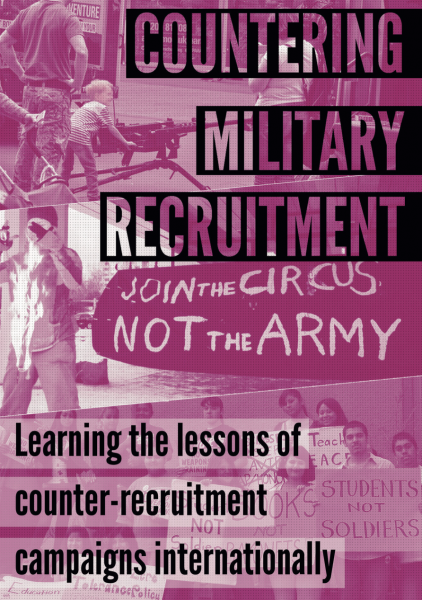
WRI's new booklet, Countering Military Recruitment: Learning the lessons of counter-recruitment campaigns internationally, is out now. The booklet includes examples of campaigning against youth militarisation across different countries with the contribution of grassroot activists.
You can order a paperback version here.



